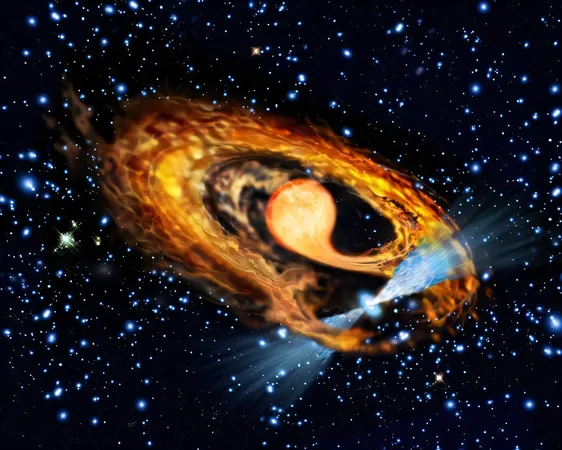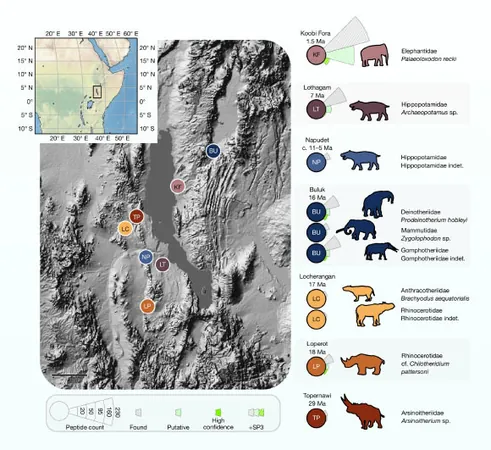
Unveiling the Secrets of 511 keV Photons: Could Millisecond Pulsars Hold the Key?
2025-05-16
Author: Amelia
The Cosmic Mystery of 511 keV Photons
Astrophysicists are on an exhilarating quest to trace the origins of specific photons in our universe, particularly the elusive 511 keV photons. These cosmic messengers are enigmatic, showing an unexpected abundance near the galactic core, yet their source has remained a mystery until now.
What Makes 511 keV Photons Unique?
The 511 keV photons are not mere specks of light; they represent the energy released when a positron meets its nemesis, the electron, resulting in annihilation. This high-energy process releases photons with a wavelength of just 2.427 picometers, placing them squarely within the gamma-ray spectrum. Understanding the origins of these photons could unlock answers to fundamental questions about the fabric of our cosmos.
A Groundbreaking Hypothesis from New Research
Recent research by Zachary Metzler and Zorawar Wadiasingh from the University of Maryland and NASA’s Goddard Space Flight Center suggests that millisecond pulsar (MSP) binaries may be a major contributor to these enigmatic photons. MSP binaries are star systems containing a pulsar that spins at astonishing speeds of just a few milliseconds per rotation.
Transformative Discoveries Await!
This line of inquiry could yield significant discoveries. One key finding highlighted by the researchers is that the 511 keV emissions could provide insights into potential exoplanets surrounding these pulsar binaries. As these binary systems orbit, the shifting dynamics can create red and blue shifts in the 511 keV signals, acting like a cosmic fingerprint of the planets in their vicinity.
Moreover, analyzing the fluctuations in photon production could also reveal critical information about the composition of the companion star. Variations in these emissions can indicate what materials are present, potentially revealing hidden worlds waiting to be discovered!
Exploring Ultra-Compact Systems and Hidden Pulsars
The research further points toward the exploration of ultra-compact systems where the pulsar and its companion star are in extremely close orbits, often overlooked in existing pulsar surveys. The energetic interactions in these systems could produce a higher concentration of 511 keV photons, opening yet another window onto the universe's hidden wonders.
Additionally, this approach provides a new perspective on pulsars themselves. By examining the 511 keV photons emitted from their interactions with companion stars, astronomers can potentially identify pulsars that would otherwise evade detection. This innovative viewpoint allows researchers to gather data even when the pulsar’s energy beam isn’t directed toward Earth.
The Future of Cosmic Exploration
While these theories remain groundbreaking yet theoretical, the future is bright. Upcoming instruments like the Compton Spectrometer and Imager (COSI), scheduled to launch in 2027, promise to enhance our observational capabilities immensely. With these powerful new tools, scientists may soon decode the secrets behind the 511 keV photons, revealing more about the fascinating dynamics of our universe.
As our understanding of these cosmic phenomena evolves, we stand on the brink of new discoveries that could redefine our comprehension of astrophysics itself, ushering in a captivating era of exploration and understanding.









 Brasil (PT)
Brasil (PT)
 Canada (EN)
Canada (EN)
 Chile (ES)
Chile (ES)
 Česko (CS)
Česko (CS)
 대한민국 (KO)
대한민국 (KO)
 España (ES)
España (ES)
 France (FR)
France (FR)
 Hong Kong (EN)
Hong Kong (EN)
 Italia (IT)
Italia (IT)
 日本 (JA)
日本 (JA)
 Magyarország (HU)
Magyarország (HU)
 Norge (NO)
Norge (NO)
 Polska (PL)
Polska (PL)
 Schweiz (DE)
Schweiz (DE)
 Singapore (EN)
Singapore (EN)
 Sverige (SV)
Sverige (SV)
 Suomi (FI)
Suomi (FI)
 Türkiye (TR)
Türkiye (TR)
 الإمارات العربية المتحدة (AR)
الإمارات العربية المتحدة (AR)